- Home
- Graham McNeill
Lords of Mars Page 8
Lords of Mars Read online
Page 8
‘If I survive this fight, I’m going to have one hell of a chemical come-down when they flush me out,’ he hissed through pursed lips. ‘That’s a Manifold purge I’m not looking forward to.’
No sooner had he initiated a full-threat auspex sweep, the kind of blaring announcement of presence a Warhound princeps was loath to initiate, than the enemy had attacked. He still wasn’t sure where they’d come from. One minute he was striding over a series of fallen stalagmites of prismatic glass, the next, four engines of comparable displacement to Amarok were attacking him.
The Warhound took the first shots on her voids, but in keeping him alive they blew out with a screaming detonation. Only Vintras’s natural reactions had kept a second volley of streaking bolts from gutting his Titan. As it was, the turbolasers had taken the brunt of the barrage.
He returned fire with the mega-bolter, feeling the pounding reverberations through the bones of his arm as he unleashed a salvo of high-explosive rounds. Like most Warhound princeps, the joints at his elbow had been replaced with shock-absorbent materials to better withstand the constant pressure of bio-feedback from his engine’s weaponry, and he was able to bear the brunt of such punishing recoil from an arm that wasn’t even his.
Something shattered into a million pieces in front of him, but a cascade of billowing ice prevented him from seeing what it was as it fell. Vintras knew better than anyone the perils of staying still in an engine fight, and pushed Amarok to striding speed. A Warhound wasn’t a gross-displacement engine that could dish out vast amounts of fire and take it at the same time, it was a hunter that thrived in high-speed war.
A flensing blast of fire blew a smoking crater in the canyon wall, and Vintras traced the shot back to its point of origin. He danced the Warhound through the crystal growths and saw another three engines striding towards him. His eyes narrowed as he took the measure of his opponents.
‘What the hell are you?’ he murmured, seeing a dreadful familiarity in their appearance.
They were Warhounds, but ones that looked like the atavistic ice sculptures left outside the fortress of the Oldbloods by the savage tribes that called Lokabrenna home.
Though these statues were moving and fighting.
But they were stupid.
They came straight at him, like ranked up regiments of Imperial Guardsmen on a parade ground. Vintras grinned and pushed the reactor to full power as he bolted for the cover of a fallen slope of rubble farther along the valley side. Shots chased him, but his control over Amarok’s movement was faultless. Even the pain of his wounded arm and the pain-balms couldn’t dull the pleasure of this moment.
A Titan commander relished a good fight, but to find yourself engaged against a foe you hopelessly outmatched was a very special pleasure.
The crystalline Titans followed him like hounds on a hunt, and Vintras led them a merry chase through the spires; darting back and forth, weaving around them and leading them just where he wanted them. Billowing clouds of glassy dust choked the canyon, but Vintras had memorised every move he’d made, like a virtuoso dancer flawlessly performing his greatest work.
The pain in his left arm faded and the Manifold surged with readiness data.
Even his voids had reset.
Amarok burst through a curtain of bright fragments, and there ahead of him were the three counterfeit Warhounds with their backs to him.
‘Imperator, I love these moments,’ he said, striding forwards at combat speed.
Instead of scattering, the enemy engines began turning on the spot like novice moderati playing at being a princeps. Vintras was on them before they were halfway rotated. He stepped between the rightmost engines and thrust his arms out to either side. The mega-bolter was primarily an infantry killer, but at point-blank range against an unshielded enemy it was an executioner’s weapon. Explosive shells ripped into the upper section of the first crystal Warhound and blasted it apart from the inside. Turbolaser fire cored the middle engine, shattering its canopy in a superhot explosion of molten fragments.
Amarok kept going, and Vintras pivoted around the falling carcass of the headless Titan to face the last remaining crystal engine. He bared his steel fangs and brought his hands together as though aiming a pistol down the firing range.
‘You might look like a Warhound, but you don’t fight like one,’ snarled the Skinwalker, unleashing both weapons into the glittering faux-Titan’s head.
Kotov had switched to a body better suited to hostile environments, an archaic robotic chassis with ray-shielded internal workings and heavy armoured plates that put him level with his skitarii escort and made him look like a ceremonial knight. His head was encased in a shimmering integrity field that sent an irritated buzzing through his aural implants, but which was still preferable to an enclosing helm.
He stepped down from the converted skitarii Rhino and looked back the way they had come. The crevasse at the end of the valley was being bridged by pioneer units disgorged from the construction decks of the Tabularium. The Cadian engineer units had nothing capable of bridging so a wide a gap, and their vehicles were forced to wait along with everyone else. Judging by the vox passing between Captain Hawkins’s Chimera and Colonel Anders’s Salamander, that delay sat ill with the men of Cadia.
A thousand servitors, load-lifters and construction engines were manoeuvring heavy, girder-braced spars of plasteel into place, and robed adepts on suspended platforms drilled bracing struts onto the inner faces of the crevasse.
But it was going to take time to construct something capable of bearing the unimaginable mass of a Land Leviathan, and Kotov couldn’t wait that long. He wanted to taste his moment of triumph first-hand, not filtered through a pict-capture or hololithic representation.
He would see the Tomioka with his own augmetic eyes.
Lupa Capitalina stood immobile behind the Tabularium, a towering representation of the Omnissiah in his aspect of war. Occasional puffs of ejected vapour and thermal bleed from its armoured reactor gave the lie to its dormancy. The Warlord was a warrior on hair-trigger, taut and poised for action. Under normal circumstances, the reassurance a fully armed Warlord Titan imparted would be welcome, but after the incident in the training decks, everyone was understandably skittish around the mighty war machine. Legio Sirius adepts had assured Kotov that the Wintersun’s lapse could never happen again, but as Kotov well knew, the Mechanicus never deletes anything.
The Warhounds that had accompanied the Wintersun to the surface were nowhere to be seen, but that wasn’t unusual; the princeps of such engines were wilful and preferred to remain unseen.
Satisfied all was proceeding as fast as could be expected, Kotov set off to the opening of the valley, where Roboute Surcouf and two members of his crew awaited him.
‘You should let my skitarii scout this place out first,’ said Dahan, emerging from a second Rhino and marching to join him with a loping, mechanical gait. ‘We don’t know what’s up here, and if Surcouf is to be believed, the Tomioka might still have active defences in place.’
The fleshy part of the Secutor’s face was encased in an oxygenated membrane gel that rippled across his skull like a thin coating of water. All four of his arms were extended, his digital scarifiers crackling with sparking lightning and his Cebrenian halberd held at the ready in his upper limbs.
‘Even after nearly four thousand years?’
‘Mechanicus tech isn’t fragile,’ Dahan reminded him. ‘It’s built to endure.’
‘You’re right, of course, Hirimau,’ said Kotov, ‘but I think we are well protected, don’t you?’
‘Better to know than to think,’ grunted Dahan.
‘Spoken like a true priest of Mars,’ said Kotov without any trace of irony.
Twenty skitarii followed the archmagos, armoured in non-reflective carapace that seamlessly shifted in sync with their movements. Cog-toothed Mechanicus skulls were rivet-stamped to each shoulder, alongside scaled scorpions and azure spiders. Dahan’s warriors normally eschewed the
wearing of barbaric totems, but Kotov noted that two had fashioned leathery-looking cloaks from what passive receptors told him was human skin. It was the work of a picosecond to match its DNA profile with that of the batch-grown skin curtains found in the Valette infirmary.
Most of the skitarii came armed with solid-slug weapons, though two were implanted with flame units and a last warrior was equipped with twin meltaguns, one as a replacement arm, the other as a shoulder mount. All carried a variety of close-combat weapons; a mix of sabres, axes and falchions with energised edges and saw-blade teeth. Their faces were obscured by tinted visors that had darkened to a deep bronze.
Galatea had elected to remain aboard the Tabularium, which struck Kotov as strange, given its stated desire to kill the Lost Magos. Not that Kotov wasn’t grateful to be away from the abominable creature, but he couldn’t shake the niggling suspicion that the hybrid machine intelligence wasn’t being entirely honest with them.
Whatever the truth of Galatea’s ultimate agenda, it would have to wait.
With Dahan at his side, Kotov clambered through the nitrogen-wreathed rocks to the top of the fissure. Surcouf climbed down from his grav-sled and held out a hand to him.
‘You made it, archmagos,’ he said. ‘It’s quite a sight, isn’t it?’
Kotov didn’t answer the rogue trader, his gaze drawn to the dizzying height of the starship standing on its ice-encased engines in the centre of the glassy ice plateau. Of all the things he had expected, this had featured in none of his dreams of finding the Tomioka. Far from being a victim of atmospheric poisoning or rampant exaggeration, Surcouf had, if anything, undersold how incredible the sight of the landed starship would be.
‘Ave Deus Mechanicus…’ he said, his mouth hanging slack at the impossible sight of a seven-kilometre starship standing proud like a hive starscraper.
‘I know,’ said Surcouf, understanding his awe. ‘I still have a hard time believing it’s real.’
Kotov tried to find some frame of reference to bring the idea of a landed starship into some kind of focus, but the sight of it standing so incongruously in the landscape was one that fitted no model of reality.
‘I have never heard of a vessel this size surviving atmospheric transit, let alone being successfully landed,’ said Dahan.
‘Telok must have brought it in exactly perpendicular to the surface,’ said Kotov, finally imposing a measure of order on his cascading thoughts. ‘Or else it would have broken its keel and spread itself all over the surface.’
‘Is that even possible?’ asked Surcouf, unlimbering a pair of magnoculars and training it on a glittering cloud of mist a kilometre or so ahead of them.
‘The ship’s plasma engines allowed the ship to penetrate far enough into the ice for it to remain upright,’ said Kotov, more to himself than in answer of Surcouf.
‘What is that?’ asked Dahan, training his own combat optics on the mist cloud Surcouf was examining. ‘Is that the Barisan?’
‘It must be,’ agreed Surcouf. ‘It’s right at the end of what looks like an impact gouge in the ground. I think the Templars crashed, but it’s hard to make anything out.’
‘The umbra is damping all auspex readings and hexing the blessed workings of machines within the limits of this plateau,’ said Kotov, suddenly realising that the dimensions of this encircled plateau were a virtually perfectly match for the diameter of the distortion Linya Tychon had detected.
‘We’re within it, and the grav-sled is still functional,’ said Surcouf. ‘If it’s being generated from the Tomioka, then it looks like it doesn’t extend all the way to ground level.’
‘If the Black Templars have crash landed, we should go to their aid,’ said Dahan.
Kotov was inclined to damn the Space Marines and let them suffer the consequences of their foolhardy zeal, but quelled so petty a notion. Dahan was right, if the Adeptus Astartes required assistance, he was duty-bound to offer it. He switched through his visual perception modes and multiple hues descended over the landscape as he saw in expanded wavelengths, sound vibrations, radiation decay and a host of other sensory inputs. Irritatingly, it seemed Surcouf was correct in deducing that the umbra did not reach ground level, as his augmetic senses had no trouble penetrating the umbra below fifty metres.
Just as what he had first seen upon reaching the edge of the plateau made no sense, what he was seeing now made just as little sense. With a thought, he switched Dahan’s optics to match his own and exloaded the correct perceptual mode to Surcouf’s magnoculars.
‘Magos Dahan,’ said Kotov. ‘The Templars are under attack. Send in the skitarii.’
Magos Dahan detested riding into battle within the hull of an armoured vehicle, equating its metallic confinement to the interior of a tomb. He had adopted the usage of the Iron Fist for just that reason, preferring to ride in an open-topped vehicle, like a barbarian king of Old Earth charging towards the enemy on his war-chariot.
The image was an apt one, for he stood on the armoured topside of a crimson and black Rhino as it led his skitarii towards the beleaguered Black Templars. His clawed legs were braced on the side and rear holdbars, while his deactivated scarifiers clamped onto the cupola mount of the commander’s hatch. His upper arms were free, and he had slung his halberd in favour of deploying a pair of forearm-mounted rotary lasers.
Denying the Cadian units permission to cross the partially completed pioneer bridge, Dahan had led his skitarii past the thousands of servitors and structural engineers buttressing its supports in readiness for the Tabularium’s crossing. Thirty Rhinos matched the speed of his own, heavily converted vehicles with upgraded auspex suites, additional weaponry and higher-grade command/control functionality. Each carried a squad of heavily-armed and highly-skilled warriors, men he had trained using his stochastic analysis of millions of inloaded combat doctrines which were then broken down into their component elements. It was a training regime he had believed faultless until Brother Yael of the Black Templars had – defying all statistical probability – bested him in a contest of arms. A mortal mind might have felt some affront or insult at such a defeat, but Dahan was above such petty concerns, and had incorporated the fighting styles of the Black Templars into his accumulated battle subroutines.
Interspersed with the screen of armour came the columns of weaponised servitors, tracked praetorians, mobile weapon platforms and a quad-maniple of twelve battle robots: six Cataphracts, four Crusaders and two Conquerors. Each robot’s organo-cybernetic cortex was slaved to a partitioned thought-stream of battle-implants.
No part of this battlefield was unknown to Dahan, the overclocked speed of his mental architecture plotting out a precise and constantly-updating picture of the combat arena. His threat optics – now incorporating Archmagos Kotov’s sensory inload – draped the plateau of icy rock in myriad cyan hues: strongly pigmented azures for organics, deeper cobalt shades for metallics and lighter teals for inorganic materials. Firing range bands, topographical vectors of assault and optimal engagement zones were overlaid in crisp red lines, giving Dahan the perfect datum points from which to conduct this assault.
The Black Templars fought from the topside of their partially buried Thunderhawk, which at Dahan’s increased consciousness speed appeared to be in the process of being subsumed by the ground itself. A host of crystal-formed warriors, illumined and likely empowered by a bloom of exotic energy within their chest cavities, laid siege to the Thunderhawk. Bioform analysis took them to be Space Marines, but Dahan saw they were poor imitations of Adeptus Astartes perfection.
Withering hails of bolter fire were blasting these monstrosities apart, but more were pulling themselves free from the ground with the sound of breaking glass. Perhaps two hundred or more surrounded the buried gunship, hurling themselves at the embattled Space Marines with a slow, relentless hunger. Some were equipped with crudely-shaped weaponry integral to their forms, and these fired streams of light that registered as painfully bright lances of sapphire.
Fortunately for the Space Marines, their attackers displayed an appalling lack of marksmanship, but the sheer volume of fire was forcing the Templars to employ every square metre of cover afforded by the gunship’s tailfins, opened dorsal hatches and inactive topside turrets.
A number of icons flashed onto his vision and Dahan wordlessly issued his orders.
The Conquerors came to a halt, digging into the reflective surface of the plateau with bracing claws before cycling round their heavy bolters and lascannons. Blazing gouts of fire streamed overhead, ploughing through the crystalline creatures in a thunderous cacophony of shattered crystal and arcing electrical discharge. The data lodged in Dahan’s cognitive overview.
Whatever else these creatures were, they were definitely not organic.
The Crusaders increased speed, two moving around each flank as the skitarii Rhinos ground to a halt in a blizzard of glittering ice chips. Assault doors slammed back and squads of cybernetically-enhanced warriors debarked in perfect synchrony. Each squad-chief’s right eye was a battle-implant that received situational data straight from Dahan; they knew what he knew and his binaric orders were implemented virtually instantaneously.
Like a grand-master’s regicide pieces on a tri-dimensional board, each squad moved in concert with those nearby, offering mutually supporting fields of fire and flank protection. Weaponised servitors swiftly caught up to the infantry, taking up overwatching positions to offer fire-support as and when it was required. The Cataphract robots moved alongside the infantry, their anti-personnel autocannons and power fists ready to support against any foe beyond the soldiers’ capability to engage.
Dahan released his grip on the sides of his own Rhino and dropped to the ground, unlimbering his Cebrenian halberd and igniting his clawed scarifiers. His assigned squad hove into view, and he ran to join them with his peculiar loping gait.
Skitarii gunfire smashed through the crystal creatures, blasting them apart with solid rounds or detonating them explosively with high-energy hotshots. Grenade launchers cleared space for praetorians to occupy and deny the enemy time to regroup. Dahan himself was not above getting his hands dirty, fighting with killing sweeps of his Cebrenian halberd. He assigned his own command squad, a mix of elite suzerain and experimental weapon-bearers, a path right into the heart of the fight.

 Iron Warriors - The Omnibus
Iron Warriors - The Omnibus Old Wounds, New Scars
Old Wounds, New Scars The Colonel's Monograph
The Colonel's Monograph Ursuns Teeth
Ursuns Teeth The Ambassador
The Ambassador![[Ultramarines 5] Courage and Honour - Graham McNeill Read online](http://i1.bookreadfree.com/i/03/12/[ultramarines_5]_courage_and_honour_-_graham_mcneill_preview.jpg) [Ultramarines 5] Courage and Honour - Graham McNeill
[Ultramarines 5] Courage and Honour - Graham McNeill 28a Luna Mendax
28a Luna Mendax The Legend of Sigmar
The Legend of Sigmar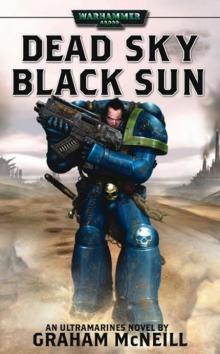 Warhammer - Ultramarines 03 - Dead Sky, Black Sun (McNeill, Graham)
Warhammer - Ultramarines 03 - Dead Sky, Black Sun (McNeill, Graham)![Warhammer - [The Ambassador Chronicles 01] - The Ambassador Read online](http://i1.bookreadfree.com/i/03/17/warhammer_-_[the_ambassador_chronicles_01]_-_the_ambassador_preview.jpg) Warhammer - [The Ambassador Chronicles 01] - The Ambassador
Warhammer - [The Ambassador Chronicles 01] - The Ambassador Priests of Mars
Priests of Mars Vengeful Spirit
Vengeful Spirit![[Sigmar 03] - God King Read online](http://i1.bookreadfree.com/i/03/13/[sigmar_03]_-_god_king_preview.jpg) [Sigmar 03] - God King
[Sigmar 03] - God King The Killing Ground
The Killing Ground The Ambassador Chronicles
The Ambassador Chronicles Mechanicum
Mechanicum![[Ulthuan 02] - Sons of Ellyrion Read online](http://i1.bookreadfree.com/i/03/14/[ulthuan_02]_-_sons_of_ellyrion_preview.jpg) [Ulthuan 02] - Sons of Ellyrion
[Ulthuan 02] - Sons of Ellyrion Magnus the Red: Master of Prospero
Magnus the Red: Master of Prospero A Thousand Sons
A Thousand Sons![[Warhammer] - Guardians of the Forest Read online](http://i1.bookreadfree.com/i/03/18/[warhammer]_-_guardians_of_the_forest_preview.jpg) [Warhammer] - Guardians of the Forest
[Warhammer] - Guardians of the Forest The Chapters Due
The Chapters Due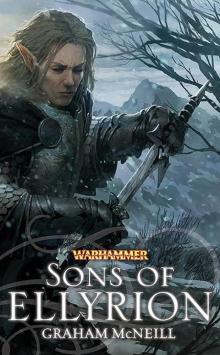 02 - Sons of Ellyrion
02 - Sons of Ellyrion Chains Of Command
Chains Of Command Angel Exterminatus
Angel Exterminatus The Ultramarines Omnibus
The Ultramarines Omnibus X Marks da Spot
X Marks da Spot Sons of Ellyrion
Sons of Ellyrion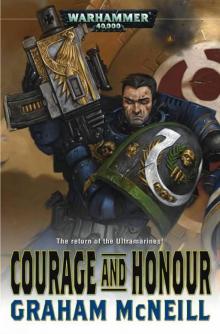 Courage And Honour
Courage And Honour Ultramarines
Ultramarines![[Ulthuan 01] - Defenders of Ulthuan Read online](http://i1.bookreadfree.com/i/03/16/[ulthuan_01]_-_defenders_of_ulthuan_preview.jpg) [Ulthuan 01] - Defenders of Ulthuan
[Ulthuan 01] - Defenders of Ulthuan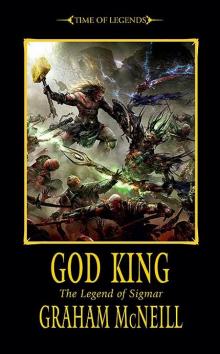 03 - God King
03 - God King Warhammer - Ultramarines 02 - Warriors Of Ultramar (McNeill, Graham)
Warhammer - Ultramarines 02 - Warriors Of Ultramar (McNeill, Graham) The Outcast Dead
The Outcast Dead Knights of the Imperium
Knights of the Imperium Defenders of Ulthuan
Defenders of Ulthuan 01 - Defenders of Ulthuan
01 - Defenders of Ulthuan Kryptos
Kryptos The Kaban Project
The Kaban Project Lords of Mars
Lords of Mars The Beast of Calth
The Beast of Calth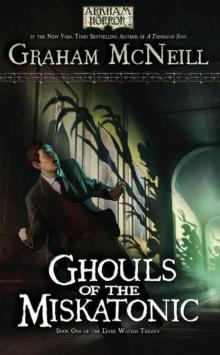 Ghouls of the Miskatonic (The Dark Waters Trilogy)
Ghouls of the Miskatonic (The Dark Waters Trilogy)![[Sigmar 01] - Heldenhammer Read online](http://i1.bookreadfree.com/i/03/24/[sigmar_01]_-_heldenhammer_preview.jpg) [Sigmar 01] - Heldenhammer
[Sigmar 01] - Heldenhammer The Enemy Of My Enemy
The Enemy Of My Enemy False Gods
False Gods Fulgrim
Fulgrim Mechanicum whh-9
Mechanicum whh-9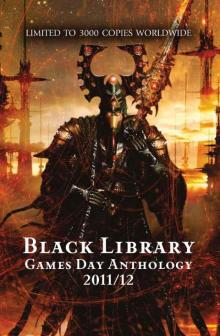 Death of a Silversmith
Death of a Silversmith Iron Warrior
Iron Warrior Courage and Honour w4u-5
Courage and Honour w4u-5![[Ultramarines 6] Chapters Due - Graham McNeill Read online](http://i1.bookreadfree.com/i1/03/30/[ultramarines_6]_chapters_due_-_graham_mcneill_preview.jpg) [Ultramarines 6] Chapters Due - Graham McNeill
[Ultramarines 6] Chapters Due - Graham McNeill The Crimson King
The Crimson King 1 the ambassador
1 the ambassador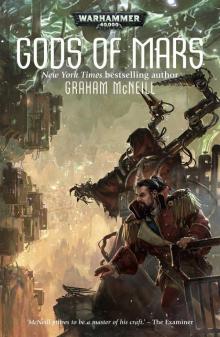 Gods of Mars
Gods of Mars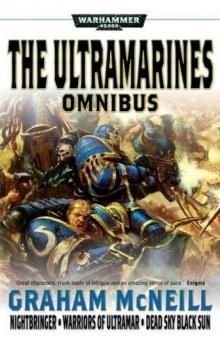 Ultramarines Omnibus (warhammer 40000: ultramarines)
Ultramarines Omnibus (warhammer 40000: ultramarines) Fulgrim: Visions of Treachery whh-5
Fulgrim: Visions of Treachery whh-5 The Kaban Project (warhammer 40000: horus heresy)
The Kaban Project (warhammer 40000: horus heresy)![[Sigmar 02] - Empire Read online](http://i1.bookreadfree.com/i1/04/05/[sigmar_02]_-_empire_preview.jpg) [Sigmar 02] - Empire
[Sigmar 02] - Empire The Lightning Tower & The Dark King
The Lightning Tower & The Dark King Wolf Hunt
Wolf Hunt Killing Ground w4u-4
Killing Ground w4u-4![Warhammer - [The Ambassador Chronicles 02] - Ursun's Teeth Read online](http://i1.bookreadfree.com/i1/04/05/warhammer_-_[the_ambassador_chronicles_02]_-_ursuns_teeth_preview.jpg) Warhammer - [The Ambassador Chronicles 02] - Ursun's Teeth
Warhammer - [The Ambassador Chronicles 02] - Ursun's Teeth 01 - Heldenhammer
01 - Heldenhammer 02 - Empire
02 - Empire False Gods whh-2
False Gods whh-2